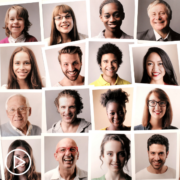Digital Advocacy and Health Equity for CLL Patients
Telemedicine or telehealth – remote access to healthcare – has become widely used after the arrival of the coronavirus pandemic, especially by cancer patients. But the rise in telemedicine has also brought challenges to the vulnerable populations of Americans over age 65 and to low-income Americans who have struggles getting online.
Among patients who are over age 65, only 55 percent to 60 percent of them have broadband access from home or own a smartphone. These patients also have challenges with completing information online, with only 60 percent who have the ability to send an email, to complete a form, and to locate a website. Among low-income patients, only 53 percent are digitally literate, and they also have lower rates of Internet use, broadband access, and smartphone ownership compared to other patient groups.
Empowering Vulnerable Communities
As an avenue toward reducing inequities, the Patient Empowerment Network (PEN) is working to foster change toward achieving equitable healthcare for all. In order to provide practical usage of telemedicine tools, PEN created the TelemEDucation Empowerment Resource Center for chronic lymphocytic leukemia (CLL) patients and their loved ones. Another resource, the digital sherpa™ program, helps cancer patients and their families become more tech-savvy by learning to use technology to their advantage during their cancer journey and beyond.
Here’s a summary view of the knowledge gained about telemedicine to help provide optimal care to CLL patients:
How to Optimize a Telemedicine Visit
Just like in-person care visits, telemedicine visits are scheduled with a time limit in mind. Some things to remember about telemedicine visits:
- If a video conferencing tool is needed for your visit, install the tool on your laptop, tablet, or smartphone ahead of time so that you aren’t rushed when your appointment time arrives.
- Just like in-person doctor visits, your doctor or care provider may run a few minutes late.
- Try your best to remain flexible and to be patient.
- Try to write down your questions before your appointment to keep on track about things you want to learn during your visit.
- Remain focused on the main purpose of your visit as much as possible. Polite small talk is fine but keep it to a minimum so that you can get the most out of your visit.
CLL Patients Who Benefit the Most From Telemedicine
Not every CLL patient will be a good fit for telemedicine visit. Things to keep as top of mind for telemedicine visits:
- CLL patients who are on active surveillance from their care providers are a natural fit for telemedicine. They can get periodic blood tests from a local laboratory, and the results can be sent electronically for their CLL specialist to evaluate.
- Patients with high-risk genetic features or rapidly progressing CLL are not the ideal patient for care via telemedicine.
In the time of the coronavirus pandemic, remote monitoring has become part of standard healthcare terms. Some things for CLL patients to know:
- Though it may be a new healthcare method for many patients, monitoring has actually been used for decades in the care of CLL patients and others with suppressed immune systems.
- Remote monitoring is used to reduce the risk of infection to those with reduced immune system function, such as those with cancer and CLL.
- Remote monitoring is a completely safe medical practice for CLL care when a patient’s blood work is monitored on a regular basis. Always ask your doctor if you’re unsure if you’re a candidate for remote monitoring or if you have questions about the frequency of your blood tests.
How Telemedicine Can Improve CLL Care
Now that even more CLL patients have become accustomed to using telemedicine care tools, CLL experts are looking to the future. Looking ahead:
- Telemedicine can help CLL patients who live in very remote areas to gain access to clinical trials that weren’t accessible to them in the past.
- CLL therapies will continue to improve for patients as a higher percentage of CLL patients participate in clinical trials.
- The improvements in remote monitoring will bring more tools for CLL patients to do routine things like sending their heart rate and other things to their care provider in real time.
Telemedicine Glossary
Here are some helpful telemedicine terms to know:
- HIPAA – HIPAA, or the Health Information Portability and Accountability Act, is a healthcare compliance law providing data security and privacy for the safeguarding of patient medical information. In telemedicine, provider-patient communication must take place through HIPAA-compliant secure platforms.
- Patient portal – a secure Internet sign-on that allows patients to contact their provider, review medical tests and records, access health education materials, and seek appointments. Most provider networks develop a patient portal before they move to full video appointments.
- Remote monitoring – type of ambulatory healthcare where patients use mobile medical devices to perform a routine test and send the test data to a healthcare professional in real-time.
- VPN – a VPN, or virtual private network, is a secure and private way to connect to the Internet over public wireless connections. VPNs are particularly important for those living the digital nomad lifestyle and connecting in foreign countries where networks may be more vulnerable to communication transmission interference.
Now that telemedicine tools are gaining both in usage and numbers, CLL patients can feel hopeful about improved care and treatment toward the future. As a step in that direction, take advantage of the resources below and continue to visit the TelemEDucation Empowerment Resource Center for informative content about CLL and telemedicine.
Resources for Telemedicine and CLL
Dr. John Pagel’s Top Tips for Preparing for Your CLL Telemedicine Visit
Telemedicine Challenges and Opportunities for CLL Patients
Will Telemedicine Mitigate Financial Toxicity for CLL Patients?
What Subset of CLL Patients Should Utilize Telemedicine?
Will Telemedicine Be Part of Routine Management for CLL?
How Will Telemedicine Impact Time-Limited Therapy in CLL?
What CLL Population Will Benefit Most From Telemedicine?
TelemEDicine ToolBox Visit Checklist
Will Telemedicine Give More CLL Patients Access to Clinical Trials?
Will Telemedicine Activate More Remote Monitoring for CLL?
Will Telemedicine Improve My Quality of Life with CLL?
Will Telemedicine Be a Long-Term Survivorship Tool for CLL Patients?
What CLL Symptoms Can Be Monitored via Telemedicine?
Is Remote Monitoring for CLL Patients on CAR T Therapy the Future?











